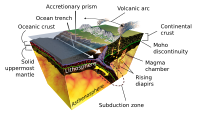
Photo from wikipedia
Abstract The mechanisms underpinning the formation of a focused volcanic arc above subduction zones are debated. Suggestions include controls by: (i) where the subducting plate releases water, lowering the solidus… Click to show full abstract
Abstract The mechanisms underpinning the formation of a focused volcanic arc above subduction zones are debated. Suggestions include controls by: (i) where the subducting plate releases water, lowering the solidus in the overlying mantle wedge; (ii) the location where the mantle wedge melts to the highest degree; and (iii) a limit on melt formation and migration imposed by the cool shallow corner of the wedge. Here, we evaluate these three proposed mechanisms using a set of kinematically-driven 2D thermo-mechanical mantle-wedge models in which subduction velocity, slab dip and age, overriding-plate thickness and the depth of decoupling between the two plates are systematically varied. All mechanisms predict, on the basis of model geometry, that the arc-trench distance, D , decreases strongly with increasing dip, consistent with the negative D -dip correlations found in global subduction data. Model trends of sub-arc slab depth, H , with dip are positive if H is wedge-temperature controlled and overriding-plate thickness does not exceed the decoupling depth by more than 50 km, and negative if H is slab-temperature controlled. Observed global H -dip trends are overall positive. With increasing overriding plate thickness, the position of maximum melting shifts to smaller H and D , while the position of the trenchward limit of the melt zone, controlled by the wedge's cold corner, shifts to larger H and D , similar to the trend in the data for oceanic subduction zones. Thus, the limit imposed by the wedge corner on melting and melt migration seems to exert the first-order control on arc position.
Journal Title: Earth and Planetary Science Letters
Year Published: 2018
Link to full text (if available)
Share on Social Media: Sign Up to like & get
recommendations!